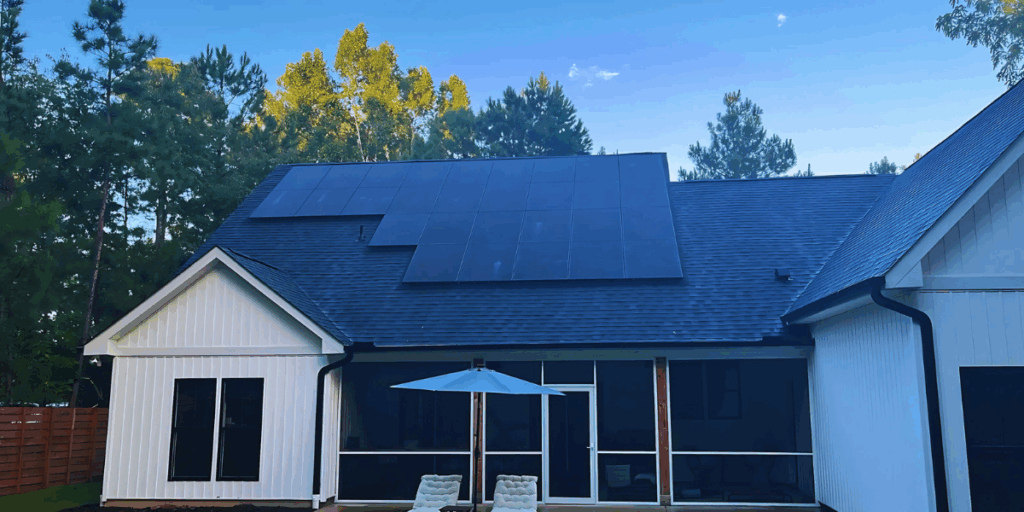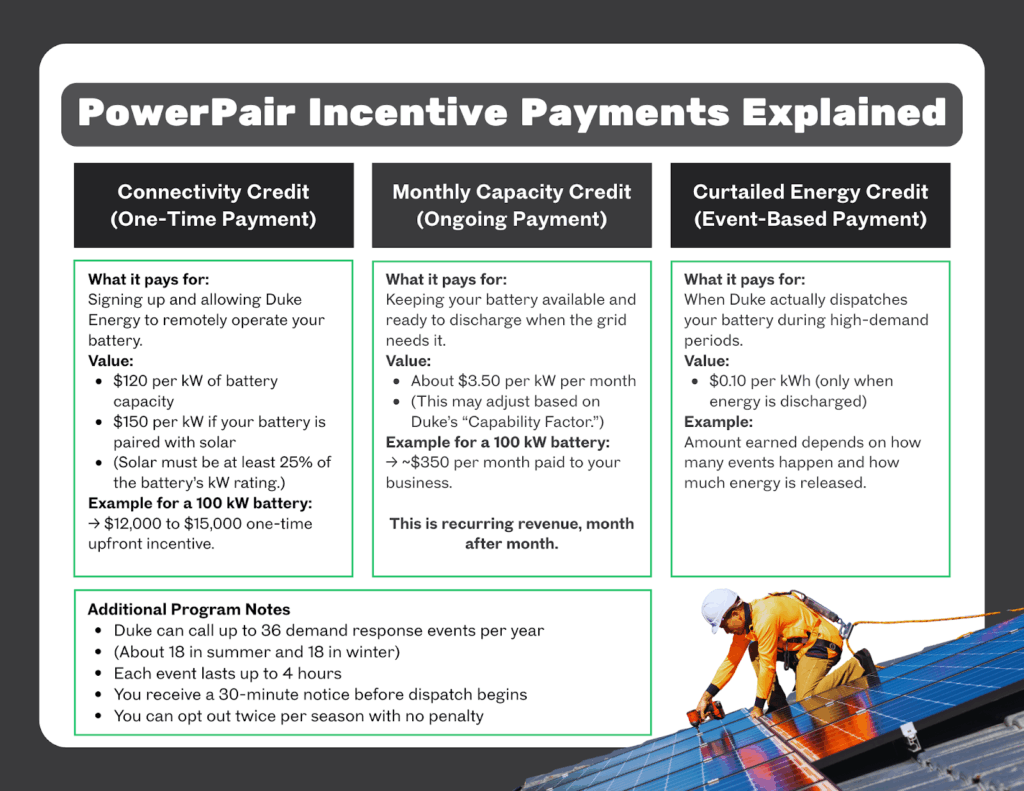Duke Energy has officially filed a groundbreaking program with the North Carolina Utilities Commission that could reshape how commercial customers approach energy storage. The Commercial PowerPair Incentive, officially called the Non-Residential Storage Demand Response Program, brings Duke Energy’s successful residential battery program to the business world. For commercial, industrial, and government customers in North Carolina, this represents an opportunity to reduce energy costs while contributing to grid stability.
If your business has been considering battery storage or solar energy, understanding this new incentive program is essential. The Commercial PowerPair Incentive offers payments for connecting your battery system to Duke Energy’s grid management system, along with ongoing monthly credits and compensation for energy dispatched during peak demand periods. While the incentive structure differs from the residential program, it opens new possibilities for businesses to monetize their energy storage investments.
Table of Contents
- What Is the Commercial PowerPair Incentive Program?
- Understanding the PowerPair Incentive Structure
- How Commercial PowerPair Demand Response Events Work
- Connectivity Options and Technical Requirements
- Comparing Commercial and Residential PowerPair Incentives
- Cost-Effectiveness and Program Economics
- Market Potential and Participation Expectations
- What This Means for Your Business
- Moving Forward with Commercial Solar and Battery Storage
What Is the Commercial PowerPair Incentive Program?
The Commercial PowerPair Incentive is Duke Energy’s response to a July 2024 stipulation agreement requiring the utility to develop a non-residential energy storage program that creates net system benefits. The program targets individually metered commercial, industrial, and governmental customers who can provide load reduction through Energy Storage Systems (ESS).
The main goal is straightforward: provide Duke Energy’s system operators with a source of capacity through load reduction that they can use at their discretion to deliver economic benefits for all customers. By enrolling in the program, businesses allow Duke Energy to remotely control their battery systems during specific events, helping the utility manage peak demand periods more efficiently.
This arrangement benefits everyone involved. Duke Energy gains flexible capacity to manage grid stress, participating businesses receive financial incentives that improve their return on battery storage investments, and all customers benefit from a more stable grid. The program builds on lessons learned from the residential PowerPair program while adapting to the needs and capabilities of commercial energy users.

Understanding the PowerPair Incentive Structure
The Commercial PowerPair Incentive includes three types of payments, each designed to reward different aspects of participation. Understanding these payment structures helps businesses calculate the potential return on their energy storage investments.
The Connectivity Credit provides a one-time payment when you enroll your Energy Storage System in the program. For battery storage configured for remote communication and control by Duke Energy, businesses receive $120 per kilowatt of battery capacity. If you pair your battery with solar panels, you can earn an additional $30 per kilowatt, bringing the total connectivity credit to $150 per kilowatt.
To qualify for the solar pairing bonus, your photovoltaic system has to be at least 25% of your battery system’s kilowatt output. This means a 100 kW battery would need at least a 25 kW solar array to receive the $30 per kilowatt credit. Both new installations and existing systems qualify for these credits, making the program accessible whether you’re planning a new solar and battery project or looking to optimize an existing installation.
Beyond the connectivity credit, the Monthly Capacity Credit provides ongoing compensation for having your system enrolled and available. Duke Energy pays $3.50 per kilowatt of your battery’s nameplate capacity, adjusted by a company-calculated “Capability Factor.” This monthly payment recognizes the value your battery provides by being ready to discharge energy when the grid needs it most.
The third payment component, the Curtailed Energy Credit, compensates you for energy dispatched from your battery during Control Events. Duke Energy pays $0.10 per kilowatt-hour for energy released from your system during these demand response events. When you combine the monthly capacity credits with the energy credits, participating businesses can generate ongoing revenue from their battery systems beyond the savings from reduced electricity bills.

How Commercial PowerPair Demand Response Events Work
Participating in the Commercial PowerPair Incentive means allowing Duke Energy to call upon your battery system during demand response events throughout the year. Understanding how these Control Events work is important for businesses evaluating if the program fits their operations.
Duke Energy can call between 30 and 36 Control Events per year, divided between winter and summer seasons. The utility can dispatch your battery up to 18 times during the winter season (October through May) and 18 times during the summer season (June through September). Each Control Event lasts a maximum of four hours, during which Duke Energy remotely discharges your battery to help meet grid demand.
The notification window for Control Events is 30 minutes. This short notice period means your battery needs to maintain sufficient charge to respond when called upon. If your business uses the battery for energy arbitrage or backup power, you’ll need to balance these uses with the requirement to be ready for demand response events.
Businesses retain some flexibility through opt-out provisions. You can opt out of two Control Events per winter season and two per summer season without penalty. This allows you to maintain control during critical business periods or when you need your battery fully charged for other purposes. Exceeding these opt-out limits results in forfeiture of capacity and energy credits for the remainder of that year, and potentially removal from the program.
Duke Energy will not discharge your battery below the manufacturer’s recommended minimum state of charge or 20%, whichever is less, where operationally feasible. This protection helps preserve battery health and longevity, guaranteeing the demand response program doesn’t compromise your equipment.
Connectivity Options and Technical Requirements
The Commercial PowerPair Incentive offers flexibility in how you connect your battery system to Duke Energy’s demand response network. The program supports automated and manual participation, though only automated connection qualifies for the connectivity credit.
For automated participation, your Energy Storage System must connect via approved communication protocols, including IEEE 2030.5 or OpenADR. These industry-standard protocols allow Duke Energy to remotely monitor and control your battery during Control Events. Most modern battery systems and inverters support these protocols, making integration straightforward.
Businesses can also participate manually without automated controls. While this option doesn’t qualify for the connectivity credit, it allows participation if your battery system lacks remote communication capabilities or if you prefer to maintain direct control. Manual participation requires you to respond to Control Event notifications by manually discharging your battery according to Duke Energy’s instructions.
The technical requirements are manageable for most commercial battery installations. Your system need to be capable of remote monitoring and control, maintain communication with Duke Energy’s systems, and respond to dispatch signals within the required timeframes. Working with an experienced solar and battery installer like 8MSolar ensures your system meets all technical requirements and integrates seamlessly with the demand response program.
Comparing Commercial and Residential PowerPair Incentives
While the Commercial PowerPair Incentive builds on the foundation of Duke Energy’s residential program, significant differences exist between the two offerings. Understanding these differences helps set realistic expectations for commercial participants.
The residential PowerPair program offered approximately $360 per kilowatt for solar-paired battery systems. The Commercial PowerPair Incentive’s $150 per kilowatt is a big reduction, reflecting different economics and market dynamics in the commercial sector. Industry analysts note this lower incentive level may challenge customer participation rates, especially for smaller commercial customers.
The commercial program emphasizes ongoing capacity and energy credits more heavily than the residential offering. The monthly capacity credits and per-kilowatt-hour energy payments create a recurring revenue stream that can improve the economics of commercial battery storage over time. For businesses with larger battery systems, these ongoing credits can add up to meaningful returns.
The control event structure also differs. Commercial customers face more frequent dispatches (up to 36 events annually) compared to residential customers, reflecting the greater grid impact that commercial-scale batteries can provide. The shorter 30-minute notification window for commercial customers versus longer notice periods in the residential program reflects another difference between commercial and residential energy users.
Cost-Effectiveness and Program Economics
Duke Energy designed the Commercial PowerPair Incentive to pass rigorous cost-effectiveness tests, making sure the program benefits all customers, not just participants. The utility reports a Benefit-Cost Ratio of 1.12 using the Utility Cost Test and Ratepayer Impact Measure Test for Duke Energy Carolinas, and 1.20 for Duke Energy Progress. These ratios demonstrate the program creates more value than it costs.
From a participant perspective, the economics depend on your situation. Businesses with large battery systems can generate large annual revenues through capacity and energy credits. A 100 kW battery system enrolled in the program would receive $15,000 in connectivity credits, plus $350 monthly in capacity credits, and additional payments for energy dispatched during Control Events.
When combined with savings from reduced demand charges, energy arbitrage opportunities, and backup power value, commercial battery storage with the Commercial PowerPair Incentive can achieve attractive payback periods. The federal Solar Investment Tax Credit of 30% further improves project economics for systems installed before the credit phases down.
Duke Energy funded the program through general funds subject to cost recovery through an annual DSM/EE cost recovery rider. This funding structure ensures program sustainability while spreading costs fairly across all customers. The utility plans regular program reviews, allowing incentive adjustments based on participation rates and cost-effectiveness results.

Market Potential and Participation Expectations
Duke Energy estimates huge market potential for the Commercial PowerPair Incentive. The utility projects approximately 1,590 eligible non-residential customer accounts for Duke Energy Carolinas and 1,690 for Duke Energy Progress that could participate.
By the fifth year of the program, Duke Energy expects to enroll over 13,000 participants in each service territory, creating more than 14,000 cumulative Summer Coincident kilowatts for Duke Energy Carolinas and nearly 14,000 for Duke Energy Progress. These projections suggest large commercial interest in battery storage paired with demand response participation.
The program includes a minimum three-year contract term, with automatic annual renewals thereafter. This commitment period provides stability for Duke Energy and participating businesses, though penalties apply for early termination. The multi-year term aligns with the typical payback period for commercial battery investments, ensuring businesses have time to realize returns on their participation.
What This Means for Your Business
The Commercial PowerPair Incentive creates a vital opportunity for businesses considering energy storage investments. Whether you’re planning a new solar and battery installation or looking to maximize the value of existing equipment, the program adds a compelling revenue stream to the traditional benefits of battery storage.
Businesses already dealing with high demand charges, frequent power quality issues, or concerns about grid reliability will find battery storage particularly attractive. The Commercial PowerPair Incentive makes these systems more economically viable by adding connectivity credits, monthly capacity payments, and energy dispatch compensation to the savings from demand charge reduction and energy arbitrage.
The program works best for businesses with predictable energy usage patterns and the ability to accommodate Control Events without disrupting operations. Manufacturing facilities, office buildings, retail locations, and government facilities all represent good candidates for participation. Working with an experienced installer helps identify whether your business’s energy profile and operational requirements align well with program participation.
Moving Forward with Commercial Solar and Battery Storage
Duke Energy officially filed the Commercial PowerPair Incentive with the North Carolina Utilities Commission on September 15, 2025. The commission is expected to issue a procedural order initiating comment periods before making a final decision. Initial comments are due November 14, with reply comments due December 5.
For businesses interested in participating, now is the time to begin planning. Solar and battery installations require careful site assessment, system design, and permitting before construction can begin. Starting the planning process now positions your business to take advantage of the Commercial PowerPair Incentive as soon as the program receives final approval.
At 8MSolar, we have extensive experience designing and installing commercial solar and battery systems throughout North Carolina. Our team understands the technical requirements for demand response programs and can help you evaluate whether the Commercial PowerPair Incentive makes sense for your business. We work with you to design systems that maximize energy savings and demand response revenues while meeting your operational needs.
The combination of falling battery costs and new utility incentive programs like the Commercial PowerPair makes 2025 an opportune time for commercial energy storage investments. Contact 8MSolar today to discuss how your business can benefit from solar energy, battery storage, and participation in Duke Energy’s Commercial PowerPair Incentive program. Let us help you navigate the technical requirements, calculate returns, and design a system that delivers energy independence and financial performance for your business.

